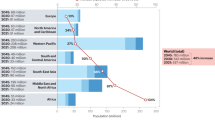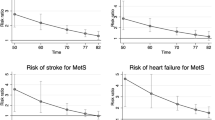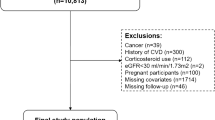Abstract
Objective:
Much has been written on the metabolic syndrome and related recent criteria. However, it remains unclear whether such criteria help clinical practice. This review will evaluate the usefulness of metabolic syndrome criteria to enhance risk prediction for either cardiovascular disease or diabetes.
Design:
This is a narrative review that is based on the author's experience from relevant publications from his group and from other related research.
Results:
Although the presence of metabolic syndrome, however defined, is clearly associated with higher risk for vascular disease, the criteria do not enhance coronary heart disease (CHD) prediction from simpler Framingham-based risk scores. The dichotomous nature of metabolic syndrome criteria—either you have it or you do not—combined with the lack of age, low-density lipoprotein cholesterol and smoking account for their inferior predictive value. Metabolic syndrome criteria are, in fact, more strongly associated with incident diabetes, an observation demonstrated in the West of Scotland Coronary Prevention Study (WOSCOPS). This is because three of the five parameters within metabolic syndrome criteria (waist, glucose and triglyceride) are more closely linked to risk for diabetes than risk for CHD. However, screening for prevalent or high risk of incident diabetes is a complex and debated issue and is by no means guaranteed to be widely adopted.
Conclusions:
Metabolic syndrome criteria do not offer benefits beyond established methods of vascular risk assessment. Thus, the focus in clinical practice should remain on established risk factors (for example, smoking, lipids, blood pressure) both to determine CHD risk, through established charts, and to reduce it.
This is a preview of subscription content, access via your institution
Access options
Subscribe to this journal
Receive 12 print issues and online access
$259.00 per year
only $21.58 per issue
Buy this article
- Purchase on Springer Link
- Instant access to full article PDF
Prices may be subject to local taxes which are calculated during checkout


Similar content being viewed by others
References
Sattar N, Gaw A, Scherbakova O, Ford I, O’Reilly DS, Haffner SM et al. Metabolic syndrome with and without C-reactive protein as a predictor of coronary heart disease and diabetes in the West of Scotland Coronary Prevention Study. Circulation 2003; 108: 414–419.
Freeman DJ, Norrie J, Sattar N, Neely RD, Cobbe SM, Ford I et al. Pravastatin and the development of diabetes mellitus: evidence for a protective treatment effect in the West of Scotland Coronary Prevention Study. Circulation 2001; 103: 357–362.
Hanley AJ, Karter AJ, Williams K, Festa A, D’Agostino Jr RB, Wagenknecht LE et al. Prediction of type 2 diabetes mellitus with alternative definitions of the metabolic syndrome: the Insulin Resistance Atherosclerosis Study. Circulation 2005; 112: 3713–3721.
Ellison TL, Elliott R, Moyes SA . HbA1c screening for undiagnosed diabetes in New Zealand. Diabetes Metab Res Rev 2005; 21: 65–70.
Ryden L, Standl E, Bartnik M, Van den Berghe G, Betteridge J, de Boer MJ, et al., Task Force on Diabetes and Cardiovascular Diseases of the European Society of Cardiology (ESC); European Association for the Study of Diabetes (EASD). Guidelines on diabetes, pre-diabetes, and cardiovascular diseases: executive summary. The Task Force on Diabetes and Cardiovascular Diseases of the European Society of Cardiology (ESC) and of the European Association for the Study of Diabetes (EASD). Eur Heart J 2007; 28: 88–136.
Lenzen M, Ryden L, Ohrvik J, Bartnik M, Malmberg K, Scholte OP, et al., Euro Heart Survey Investigators. Diabetes known or newly detected, but not impaired glucose regulation, has a negative influence on 1-year outcome in patients with coronary artery disease: a report from the Euro Heart Survey on diabetes and the heart. Eur Heart J. 2006; 27: 2969–2974.
McNeill AM, Rosamond WD, Girman CJ, Golden SH, Schmidt MI, East HE et al. The metabolic syndrome and 11-year risk of incident cardiovascular disease in the atherosclerosis risk in communities study. Diabetes Care 2005; 28: 385–390.
Stern MP, Williams K, González-Villalpando C, Hunt KJ, Haffner SM . Does the metabolic syndrome improve identification of individuals at risk of type 2 diabetes and/or cardiovascular disease? Diabetes Care 2004; 27: 2676–2681 [Published erratum appears in Diabetes Care 2005; 28: 238].
Wannamethee SG, Shaper AG, Lennon L, Morris RW . Metabolic syndrome vs Framingham Risk Score for prediction of coronary heart disease, stroke, and type 2 diabetes mellitus. Arch Intern Med 2005; 165: 2644–2650.
Sundstrom J, Riserus U, Byberg L, Zethelius B, Lithell H, Lind L . Clinical value of the metabolic syndrome for long term prediction of total and cardiovascular mortality: prospective, population based cohort study. BMJ 2006; 332: 878–882.
Girman CJ, Rhodes T, Mercuri M, Pyörälä K, Kjekshus J, Pedersen TR et al. The metabolic syndrome and risk of major coronary events in the Scandinavian Simvastatin Survival Study (4S) and the Air Force/Texas Coronary Atherosclerosis Prevention Study (AFCAPS/TexCAPS). Am J Cardiol 2004; 93: 136–141.
JBS2. Joint British Societies’ guidelines on prevention of cardiovascular disease in clinical practice. Heart 2005; 91 (Suppl 5): v1–v52.
Sattar N . The metabolic syndrome: should current criteria influence clinical practice? Curr Opin Lipidol 2006; 17: 404–411.
Sniderman A, Williams K, Haffner S, Sattar N . Insights from apoB: from better diagnosis & therapy to the Medusa Hypothesis. Atheroscler Suppl. 2004; 5: 19–24.
Williams K, Sniderman AD, Sattar N, D’Agostino Jr R, Wagenknecht LE, Haffner SM . Comparison of the associations of apolipoprotein B and low-density lipoprotein cholesterol with other cardiovascular risk factors in the Insulin Resistance Atherosclerosis Study (IRAS). Circulation 2003; 108: 2312–2316.
Wang TJ, Gona P, Larson MG, Tofler GH, Levy D, Newton-Cheh C et al. Multiple biomarkers for the prediction of first major cardiovascular events and death. N Engl J Med 2006; 355: 2631–2639.
Lean M, Gruer L, Alberti G, Sattar N . ABC of obesity. Obesity—can we turn the tide? BMJ 2006; 333: 1261–1264.
Author information
Authors and Affiliations
Corresponding author
Rights and permissions
About this article
Cite this article
Sattar, N. Why metabolic syndrome criteria have not made prime time: a view from the clinic. Int J Obes 32 (Suppl 2), S30–S34 (2008). https://doi.org/10.1038/ijo.2008.33
Published:
Issue Date:
DOI: https://doi.org/10.1038/ijo.2008.33
Keywords
This article is cited by
-
Added value of different metabolic syndrome definitions for predicting cardiovascular disease and mortality events among elderly population: Tehran Lipid and Glucose Study
European Journal of Clinical Nutrition (2014)
-
Revisiting the links between glycaemia, diabetes and cardiovascular disease
Diabetologia (2013)
-
Metabolic syndrome among Sri Lankan adults: prevalence, patterns and correlates
Diabetology & Metabolic Syndrome (2012)
-
Risk factors for type 2 diabetes in groups stratified according to metabolic syndrome: a 10-year follow-up of The Tromsø Study
European Journal of Epidemiology (2011)



